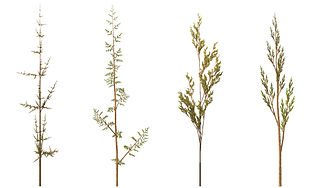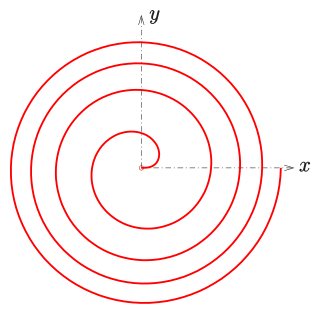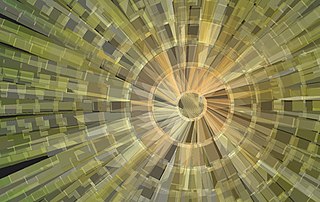Related Research Articles

Chaos theory is a branch of mathematics focusing on the study of chaos — dynamical systems whose apparently random states of disorder and irregularities are actually governed by underlying patterns and deterministic laws that are highly sensitive to initial conditions. Chaos theory is an interdisciplinary theory stating that, within the apparent randomness of chaotic complex systems, there are underlying patterns, interconnectedness, constant feedback loops, repetition, self-similarity, fractals, and self-organization. The butterfly effect, an underlying principle of chaos, describes how a small change in one state of a deterministic nonlinear system can result in large differences in a later state. A metaphor for this behavior is that a butterfly flapping its wings in Texas can cause a hurricane in China.

In mathematics, a fractal is a subset of Euclidean space with a fractal dimension that strictly exceeds its topological dimension. Fractals appear the same at different scales, as illustrated in successive magnifications of the Mandelbrot set. Fractals exhibit similar patterns at increasingly smaller scales, a property called self-similarity, also known as expanding symmetry or unfolding symmetry; if this replication is exactly the same at every scale, as in the Menger sponge, it is called affine self-similar. Fractal geometry lies within the mathematical branch of measure theory.

Aristid Lindenmayer was a Hungarian biologist. In 1968 he developed a type of formal languages that is today called L-systems or Lindenmayer Systems. Using those systems Lindenmayer modelled the behaviour of cells of plants. L-systems nowadays are also used to model whole plants.

An L-system or Lindenmayer system is a parallel rewriting system and a type of formal grammar. An L-system consists of an alphabet of symbols that can be used to make strings, a collection of production rules that expand each symbol into some larger string of symbols, an initial "axiom" string from which to begin construction, and a mechanism for translating the generated strings into geometric structures. L-systems were introduced and developed in 1968 by Aristid Lindenmayer, a Hungarian theoretical biologist and botanist at the University of Utrecht. Lindenmayer used L-systems to describe the behaviour of plant cells and to model the growth processes of plant development. L-systems have also been used to model the morphology of a variety of organisms and can be used to generate self-similar fractals.

Fractal compression is a lossy compression method for digital images, based on fractals. The method is best suited for textures and natural images, relying on the fact that parts of an image often resemble other parts of the same image. Fractal algorithms convert these parts into mathematical data called "fractal codes" which are used to recreate the encoded image.

A pattern is a regularity in the world, in human-made design, or in abstract ideas. As such, the elements of a pattern repeat in a predictable manner. A geometric pattern is a kind of pattern formed of geometric shapes and typically repeated like a wallpaper design.

A fractal landscape is a surface generated using a stochastic algorithm designed to produce fractal behavior that mimics the appearance of natural terrain. In other words, the result of the procedure is not a deterministic fractal surface, but rather a random surface that exhibits fractal behavior.

A Fermat's spiral or parabolic spiral is a plane curve named after Pierre de Fermat. Its polar coordinate representation is given by

In geometry, the golden angle is the smaller of the two angles created by sectioning the circumference of a circle according to the golden ratio; that is, into two arcs such that the ratio of the length of the smaller arc to the length of the larger arc is the same as the ratio of the length of the larger arc to the full circumference of the circle.

In mathematics, iterated function systems (IFSs) are a method of constructing fractals; the resulting fractals are often self-similar. IFS fractals are more related to set theory than fractal geometry. They were introduced in 1981.

Przemysław (Przemek) Prusinkiewicz is a Polish computer scientist who advanced the idea that Fibonacci numbers in nature can be in part understood as the expression of certain algebraic constraints on free groups, specifically as certain Lindenmayer grammars. Prusinkiewicz's main work is on the modeling of plant growth through such grammars.

Algorithmic art or algorithm art is art, mostly visual art, in which the design is generated by an algorithm. Algorithmic artists are sometimes called algorists.

Mathematical beauty is the aesthetic pleasure typically derived from the abstractness, purity, simplicity, depth or orderliness of mathematics. Mathematicians often express this pleasure by describing mathematics as beautiful. They might also describe mathematics as an art form or, at a minimum, as a creative activity. Comparisons are often made with music and poetry.

Fractal-generating software is any type of graphics software that generates images of fractals. There are many fractal generating programs available, both free and commercial. Mobile apps are available to play or tinker with fractals. Some programmers create fractal software for themselves because of the novelty and because of the challenge in understanding the related mathematics. The generation of fractals has led to some very large problems for pure mathematics.

The simulated growth of plants is a significant task in of systems biology and mathematical biology, which seeks to reproduce plant morphology with computer software. Electronic trees (e-trees) usually use L-systems to simulate growth. L-systems are very important in the field of complexity science and A-life. A universally accepted system for describing changes in plant morphology at the cellular or modular level has yet to be devised. The most widely implemented tree-generating algorithms are described in the papers "Creation and Rendering of Realistic Trees", and Real-Time Tree Rendering
Digital morphogenesis is a type of generative art in which complex shape development, or morphogenesis, is enabled by computation. This concept is applicable in many areas of design, art, architecture, and modeling. The concept was originally developed in the field of biology, later in geology, geomorphology, and architecture.
Karl Joseph Niklas is the Liberty Hyde Bailey Professor emeritus in the Section of Plant Biology, School of Integrative Plant Science, at Cornell University. He is best known for his work on plant biomechanics, allometry, and functional morphology, and for his long-standing contributions to understanding plant evolutionary biology, particularly early land plant evolutionary diversification patterns and morphospaces.
Natural computing, also called natural computation, is a terminology introduced to encompass three classes of methods: 1) those that take inspiration from nature for the development of novel problem-solving techniques; 2) those that are based on the use of computers to synthesize natural phenomena; and 3) those that employ natural materials to compute. The main fields of research that compose these three branches are artificial neural networks, evolutionary algorithms, swarm intelligence, artificial immune systems, fractal geometry, artificial life, DNA computing, and quantum computing, among others.

Patterns in nature are visible regularities of form found in the natural world. These patterns recur in different contexts and can sometimes be modelled mathematically. Natural patterns include symmetries, trees, spirals, meanders, waves, foams, tessellations, cracks and stripes. Early Greek philosophers studied pattern, with Plato, Pythagoras and Empedocles attempting to explain order in nature. The modern understanding of visible patterns developed gradually over time.
Viewpoints: Mathematical Perspective and Fractal Geometry in Art is a textbook on mathematics and art. It was written by mathematicians Marc Frantz and Annalisa Crannell, and published in 2011 by the Princeton University Press (ISBN 9780691125923). The Basic Library List Committee of the Mathematical Association of America has recommended it for inclusion in undergraduate mathematics libraries.
References
- ↑ Algorithmic Botany at the University of Calgary: The Algorithmic Beauty of Plants
- 1 2 Klir, George J. (1991). "A Review of: "THE ALGORITHMIC BEAUTY OF PLANTS" by Przemyslaw Prusinkiewicz and Aristid Lindenmayer, Springer-Verlag, New York, 1990. XII+ 228 pages". International Journal of General Systems. 18 (4): 407–408. doi:10.1080/03081079108935156.
- ↑ Bell, Adrian D. (March 1997). "The Algorithmic Beauty of Plants. by Przemyslaw Prusinkiewicz; Aristid Lindenmayer Review". New Phytologist . 135 (3): 567–568. doi: 10.1046/j.1469-8137.1997.00655-1.x . JSTOR 2559062.
- ↑ Antonelli, Peter L. (March 1992). "The Algorithmic Beauty of Plants. by Przemyslaw Prusinkiewicz; Aristid Lindenmayer Review". SIAM Review . 34 (1): 142–143. doi:10.1137/1034030. JSTOR 2132804.
- ↑ Niklas, Karl J. (December 1996). "The Algorithmic Beauty of Plants. The Virtual Laboratory. Przemyslaw Prusinkiewicz, Aristid Lindenmayer, James S. Hanan, F. David Fracchia, Deborah R. Fowler, Martin J. M. deBoer, Lynn Mercer". The Quarterly Review of Biology (Review). 71 (4): 573. doi:10.1086/419584. JSTOR 3037056.